- Products
- Dharmaconスクリーニングライブラリー
CRISPRmod CRISPRa Synthetic sgRNA Libraries
CRISPRmod CRISPRa synthetic sgRNA libraries enable one-gene-per-well investigation using high-content assays to answer in-depth biological questions. Further your drug discovery, pathway analysis, or disease progression studies with CRISPR activation screening.
Don't see your gene family of choice? Upload your own gene to our Cherry-pick Library Plater for a fully customized CRISPRa screening library.
Highlights of CRISPRa sgRNA libraries:
- Available as three individual sgRNAs per gene or a pool of three sgRNAs to provide highly effective transcriptional activation (see Supporting Data tab)
- Algorithm-generated designs (published by Horlbeck, et. al.1) demonstrate robust transcript activation (See References tab)
- Chemically modified CRISPRa sgRNAs provide additional stability against nuclease degradation and improve overall performance
- Conveniently arrayed in 96- or 384-well plates and offered as gene family collections. Echo-qualified 384-well plates are available upon request
Required components for an CRISPRa gene activation experiment using synthetic sgRNA:
- Lentiviral particles for dCas9-VPR2; a mammalian codon-optimized S. pyogenes deactivated Cas9 fused to VPR activation domains
| Human CRISPRa sgRNA Libraries | # genes (approximate) |
|---|---|
| Cell Cycle Regulation | 169 |
| Cytokine Receptors | 110 |
| Deubiquitinating Enzymes | 94 |
| DNA Damage Response | 240 |
| Drug Targets | 3686 |
| Druggable Genome* | 8422 |
| Epigenetics | 835 |
| G Protein-coupled Receptors | 390 |
| Genome | 19,127 |
| Ion channels | 417 |
| Membrane Trafficking | 140 |
| Nuclear Receptors | 52 |
| Phosphatases | 254 |
| Proteases | 576 |
| Protein Kinases | 746 |
| Transcription Factors | 1580 |
| Tyrosine Kinases | 90 |
| Ubiquitin Enzymes | 738 |
*Druggable genome is made up of: Proteases, Protein Kinases, Phosphatases, Transcription Factors, Ubiquitin Enzymes, GPCRs, Ion Channels and Drug Targets.
How much CRISPRa sgRNA do I need?
This table provides the approximate number of experiments that can be carried out for lipid transfection methods at the recommended sgRNA working concentration (25 nM) in various plate/well formats using either a pool or individual sgRNA. Calculations do not account for pipetting errors.
| sgRNA nmol | 96-well plate 100 µL volume | 24-well plate 500 µL volume | 12-well plate 1000 µL volume | 6-well plate 2500 µL volume |
|---|---|---|---|---|
| 2 | 800 | 160 | 80 | 32 |
| 5 | 2000 | 400 | 200 | 80 |
| 10 | 4000 | 800 | 400 | 160 |
Individual CRISPRa sgRNAs achieve robust target gene activation as individual or pooled reagents

U2OS cells stably expressing integrated CRISPRa dCas9-VPR were plated at 10,000 cells/well and transfected using DharmaFECT 1 Transfection Reagent (0.2 uL/well) with 25 nM CRISPRa single or pooled synthetic single guide RNA (sgRNA) targeting POU5F1, SOX2, EGFR, MYC1 or TTN. Cells were harvested at 72 hours post-transfection and gene expression was assessed using RT-qPCR. Relative fold transcriptional activation for each gene was calculated with the Cq method using beta-actin as the housekeeping gene and normalized to an experiment using non-targeting control sgRNA.
Individual CRISPRa crRNAs achieve robust target gene activation on their own, or when pooled together in a single reagent
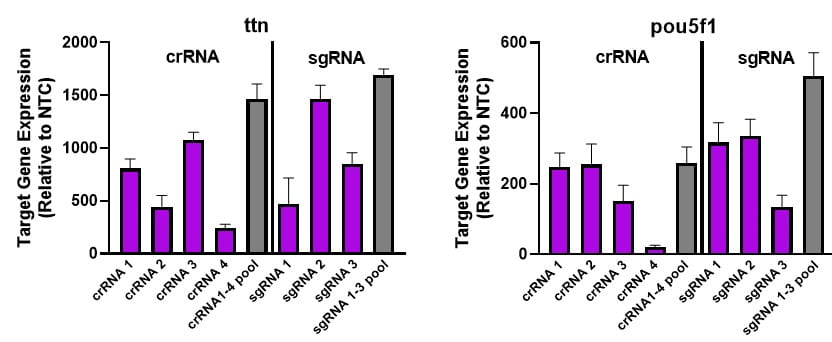
NIH-3T3 cells stably expressing integrated CRISPRa dCas9-VPR (driven by mCMV promoter) were plated at 10,000 cells/well and transfected using DharmaFECT 1 Transfection Reagent (0.2 uL/well) with CRISPRa synthetic single guide RNA (sgRNA) targeting ttn or pou5f1 genes. Four CRISPRa sgRNAs were used either individually or pooled (to an individual or pooled concentration of 25 nM). Cells were harvested at 72 hours post-transfection and gene expression was assessed using RT-qPCR. Relative fold transcriptional activation for each gene was calculated with the Cq method using beta-actin as the housekeeping gene and normalized to an experiment using non-targeting control sgRNA.
Gene activation using CRISPRa synthetic single guide RNA in dCas9-VPR stable human and mouse cell lines

Human U2OS or mouse NIH-3T3 cells stably expressing integrated CRISPRa dCas9-VPR (driven by hEF1a promoter in human and mCMV promoter in mouse cells) were plated at 10,000 cells/well and transfected using DharmaFECT 1 Transfection Reagent (0.2 uL/well) with 25 nM individual or pooled CRISPRa synthetic single guide RNA (sgRNA) targeting either human (TTN or POU5F1) mouse (pou5f1 or ttn) gene targets. Cells were harvested at 72 hours post-transfection and gene expression was assessed using RT-qPCR. Relative fold transcriptional activation for each gene was calculated with the Cq method using beta-actin as the housekeeping gene and normalized to an experiment using non-targeting control sgRNA.
sgRNA dose response curve demonstrates effective gene activation at 25 mM sgRNA concentration
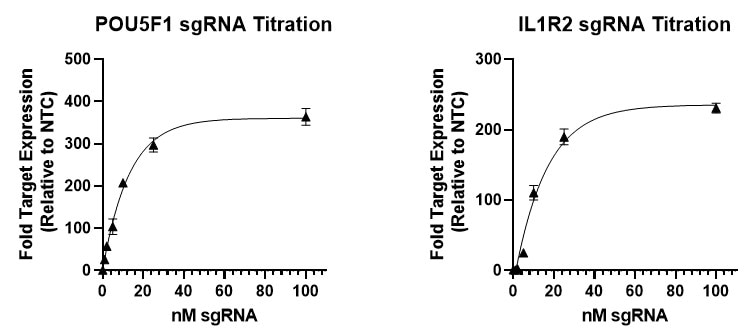
U2OS-dCas9-VPR stable cells were plated at 10,000 cells/well and transfected using 0.2 uL/well DharmaFECT 1 Transfection Reagent with CRISPRa synthetic single guide RNA (sgRNA) targeting POU5F1 or IL1R2 at six concentrations (0, 1, 5, 10, 25 and 100 nM). At 72 hours post-transfection, cell lysates were used to generate total cDNA, from which target gene expression was assessed using RT-qPCR. Relative expression of each gene was calculated with the Cq method using beta-actin mRNA as the housekeeping gene and normalized to a non-targeting control. Data points were fit to a one phase exponential decay equation.
CRISPRa gene activation fold depends on the endogenous gene expression level
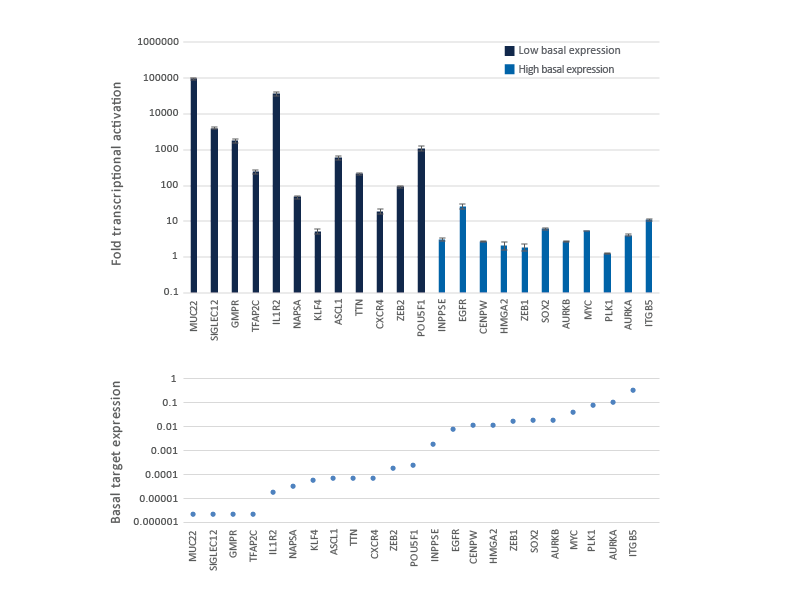
Genes with low or no basal expression are easier to activate to a robust level, while genes already expressed at high level are more difficult to further over-express. U2OS-dCas9-VPR stable cells were plated at 10,000 cells/well and transfected using DharmaFECT 4 Transfection Reagent with CRISPRa synthetic crRNA:tracrRNA pools (25 nM) targeting 23 genes with different basal level of expression. Cells were harvested 72 hours post-transfection and the relative gene expression was measured using RT-qPCR. The CRISPRa-mediated fold transcriptional activation is shown in the upper graph where the genes are ordered from low to high level of basal transcript expression in samples treated with NTC control and is shown in the lower graph as basal target gene expression (compared to GAPDH control).
CRISPRa gene activation is observed at 24 hours and peaks at 48-72 hours
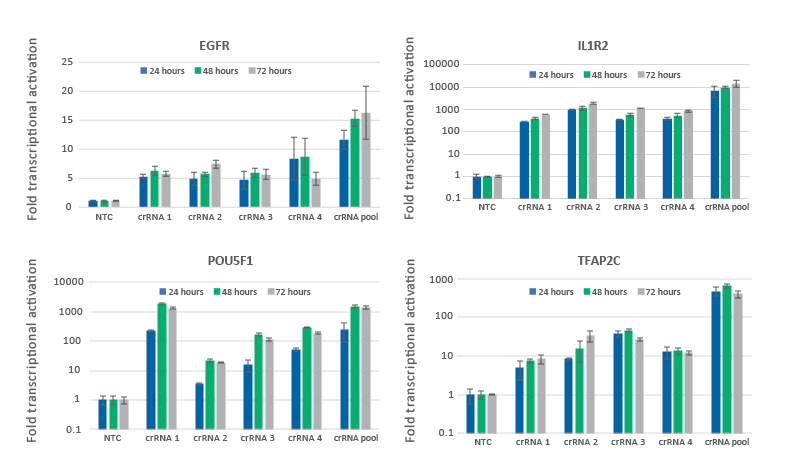
U2OS-dCas9-VPR stable cells were plated at 10,000 cells/well and transfected using DharmaFECT 4 Transfection Reagent with CRISPRa synthetic crRNA:tracrRNA targeting EGFR, IL1R2, POU5F1 or TFAP2C. Four CRISPRa crRNAs were used either individually or pooled (to a total concentration of 25 nM). Cells were harvested at 24, 48, and 72 hours post-transfection and the relative gene expression was measured using RT-qPCR. The relative expression of each gene was calculated with the Cq method using GAPDH as the housekeeping gene and normalized to a non-targeting control.
Robust CRISPRa gene activation peaks between 24 to 72 hours
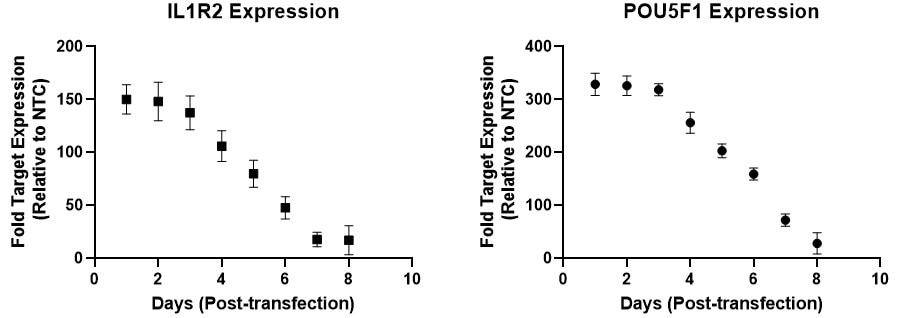
U2OS-dCas9-VPR stable cells were plated at 5,000 cells/well and transfected using 0.2 uL / well DharmaFECT 1 Transfection Reagent with 25 nM CRISPRa synthetic single guide RNA (sgRNA) targeting POU5F1, IL1R2, or non-targeting control (NTC). Transfected cells were passaged every 2-3 days to avoid overconfluency. Cells were harvested at 72 hours post-transfection and gene expression was assessed using RT-qPCR. Relative fold transcriptional activation for each gene was calculated with the Cq method using beta-actin as the housekeeping gene and normalized to an experiment using non-targeting control sgRNA.
- Horlbeck MA, Gilbert LA, et. al., Compact and highly active next-generation libraries for CRISPR-mediated gene repression and activation. 2016 Sep 23;5. pii: e19760. doi: 10.7554/eLife.19760. PubMed 27661255.
-
Chavez A, Scheiman J et. al., Highly efficient Cas9-mediated transcriptional programming Nat Methods. 2015 Mar 2. doi: 10.1038/nmeth.3312. 10.1038/nmeth.3312 PubMed 2573049.
- Tanenbaum ME, Gilbert LA, et. al., A protein tagging system for signal amplification in gene expression and fluorescence imaging. Cell. 2014;159(3):635-646. doi:10.1016/j.cell.2014.09.039. PubMed 25307933
